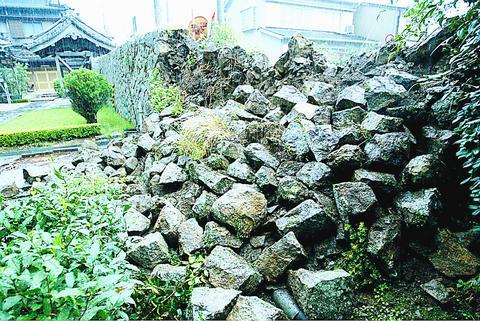Strong aftershocks rattled western Japan early yesterday after two powerful earthquakes the evening before injured 38 people.
Meanwhile, a powerful typhoon hit Japan's southern islands, injuring 21 people, and the Meteorological Agency warned the storm could bring heavy rains and mudslides to areas hit by the temblors.

PHOTO: AP
The two offshore quakes on Sunday -- the first with a magnitude of 6.9, followed by a 7.3-magnitude temblor five hours later -- were felt most strongly in sparsely populated areas in southwestern Wakayama prefecture, about 450km west of Tokyo.
They also shook the major cities of Osaka, Kyoto and Nagoya, and caused buildings to sway in Tokyo.
The National Police Agency said 38 people were hurt, including three people with broken bones. Most were injured in the second, more powerful quake.
Aftershocks continued to rattle the region early yesterday, including a magnitude-5.7 tremor, according to the Meteorological Agency. No damage or injuries were immediately reported.
"A series of magnitude-5 after-shocks could continue up to the next 10 days. They could cause tsunami waves, and I urge people to evacuate to higher ground," public broadcaster NHK quoted Yoshinobu Tsuji, assistant professor at the University of Tokyo's Earthquake Research Institute, as saying yesterday.
Tsunami -- waves triggered by seismic activity -- as high as 90cm were recorded along the Pacific coastline on Sunday, though the Meteorological Agency lifted its tsunami warnings early yesterday.
Kyodo News agency also reported that 600 homes were without electricity, while high-speed train services were temporarily suspended.
Also yesterday, Typhoon Songda was packing winds of up to 144kph as it headed across the East China Sea toward Japan's southernmost main island of Kyushu, the Meteorological Agency said.
Police said 21 people had been injured by the storm and tens of thousands of homes were without electricity.
Though the typhoon is still far away from quake-hit areas, the Meteorological Agency said the storm could bring heavy rains and warned that landslides were increasingly likely following the temblors.
The two quakes late on Sunday occurred far off Japan's Pacific coast, which may have minimized damage.
The first quake was centered about 110km off the coast of Wakayama on the Kii peninsula and 10km beneath the ocean floor.
The second quake was centered about 130km off the coast of Kochi prefecture, also 10km below the seabed.
Authorities said it was too early to say whether the bigger of the two earthquakes was the major jolt the Japanese government had predicted would strike central Japan.

A fire caused by a burst gas pipe yesterday spread to several homes and sent a fireball soaring into the sky outside Malaysia’s largest city, injuring more than 100 people. The towering inferno near a gas station in Putra Heights outside Kuala Lumpur was visible for kilometers and lasted for several hours. It happened during a public holiday as Muslims, who are the majority in Malaysia, celebrate the second day of Eid al-Fitr. National oil company Petronas said the fire started at one of its gas pipelines at 8:10am and the affected pipeline was later isolated. Disaster management officials said shutting the

US Vice President J.D. Vance on Friday accused Denmark of not having done enough to protect Greenland, when he visited the strategically placed and resource-rich Danish territory coveted by US President Donald Trump. Vance made his comment during a trip to the Pituffik Space Base in northwestern Greenland, a visit viewed by Copenhagen and Nuuk as a provocation. “Our message to Denmark is very simple: You have not done a good job by the people of Greenland,” Vance told a news conference. “You have under-invested in the people of Greenland, and you have under-invested in the security architecture of this

Japan unveiled a plan on Thursday to evacuate around 120,000 residents and tourists from its southern islets near Taiwan within six days in the event of an “emergency”. The plan was put together as “the security situation surrounding our nation grows severe” and with an “emergency” in mind, the government’s crisis management office said. Exactly what that emergency might be was left unspecified in the plan but it envisages the evacuation of around 120,000 people in five Japanese islets close to Taiwan. China claims Taiwan as part of its territory and has stepped up military pressure in recent years, including

UNREST: The authorities in Turkey arrested 13 Turkish journalists in five days, deported a BBC correspondent and on Thursday arrested a reporter from Sweden Waving flags and chanting slogans, many hundreds of thousands of anti-government demonstrators on Saturday rallied in Istanbul, Turkey, in defence of democracy after the arrest of Istanbul Mayor Ekrem Imamoglu which sparked Turkey’s worst street unrest in more than a decade. Under a cloudless blue sky, vast crowds gathered in Maltepe on the Asian side of Turkey’s biggest city on the eve of the Eid al-Fitr celebration which started yesterday, marking the end of Ramadan. Ozgur Ozel, chairman of the main opposition Republican People’s Party (CHP), which organized the rally, said there were 2.2 million people in the crowd, but